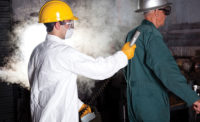Everyone is exposed to radiation every day and sources of radiation often surround us. Some are natural and some are man-made, but we can’t see or feel radiation’s presence. It is used in medical treatments and traces can be found during air travel and in nature.
But there are very few situations where an average person is exposed to uncontrolled sources of radiation beyond typical environmental exposure. Still, it’s wise to be prepared and know what to do in case of dangerous levels.
Doses of radiation
The term “radiation” is broad, and includes light and radio waves. Ionizing radiation is the one that most people are concerned with. Ionizing radiation passes through matter, which can cause it to become electrically charged or ionized. Radiation can be detected and measured in the tiniest quantities with radiation measuring instruments.
The biological effects of ionizing radiation vary with the type and energy. A measure of the risk of biological harm is the dose of radiation that the tissues receive. The unit of absorbed radiation dose is the sievert (Sv). Since one sievert is a large quantity, radiation doses normally encountered are expressed in millisievert (mSv) or microsievert (µSv) which are one-thousandth or one millionth of a sievert. For example, one chest X-ray will give about 0.2 mSv of radiation dose.1
On average, our radiation exposure due to all natural sources amounts to about 2.4 mSv a year, though that can vary, depending on the geographical location. By far the largest source of natural radiation exposure comes from varying amounts of uranium and thorium in the soil around the world.
In case of emergency
The Centers for Disease Control and Prevention developed the Radiation Hazard Scale to be a tool during emergencies.2
The scale provides a frame of reference for relative hazards of radiation in simple terms without using radiation measurements that may be unfamiliar to most people. It is designed specifically for use in radiation emergencies and it has been tested. It goes from levels one to five, with five being the most dangerous and lethal.
Category 1 means that radiation levels are within the normal range of natural background radiation in the environment for a geographic area. Category 3 is when radiation doses are becoming high enough where they might be increased risk of cancer to those who are exposed. To learn more about the radiation hazard categories, visit www.emergency.cdc.gov.
Contamination vs. exposure
The CDC has an infographic detailing the differences between radiation contamination and exposure.3 External contamination occurs when radioactive material comes into contact with a person's skin, hair or clothing, through the air or in solid or liquid form. Internal contamination can occur when radioactive material is swallowed or breathed in. Internal contamination can also occur when radioactive material enters the body through an open wound. Different radioactive materials can accumulate in different body organs.
A person exposed to radiation is not necessarily contaminated with radioactive material. For a person to be contaminated, radioactive material must be on or inside of a person’s body.
References:



